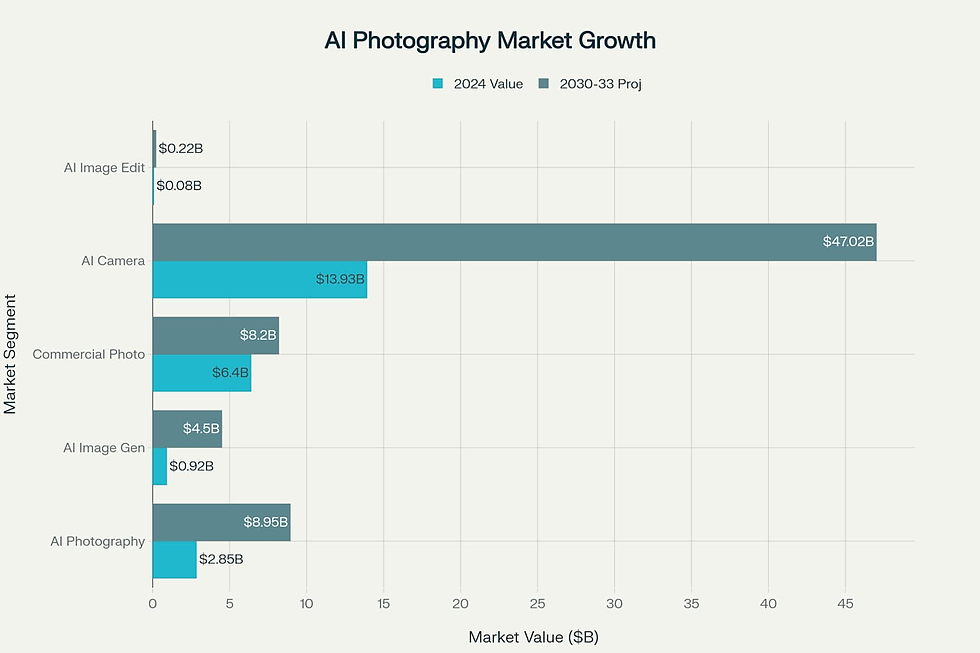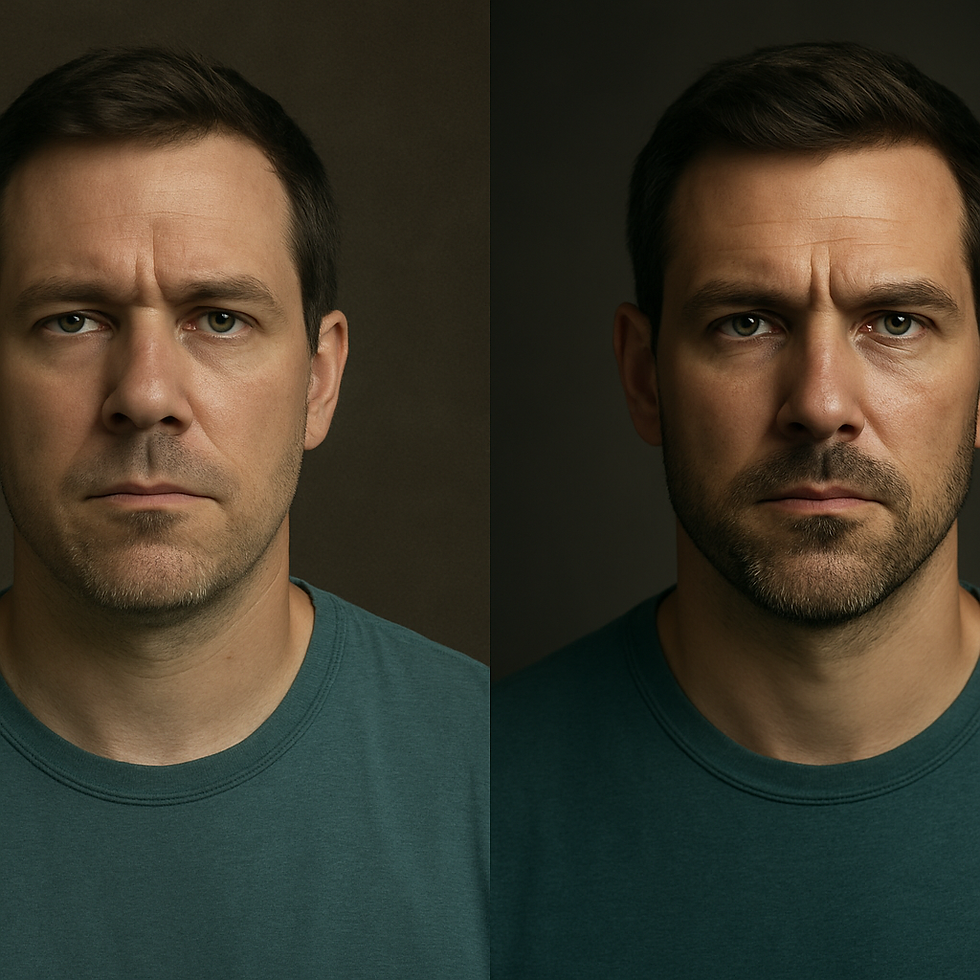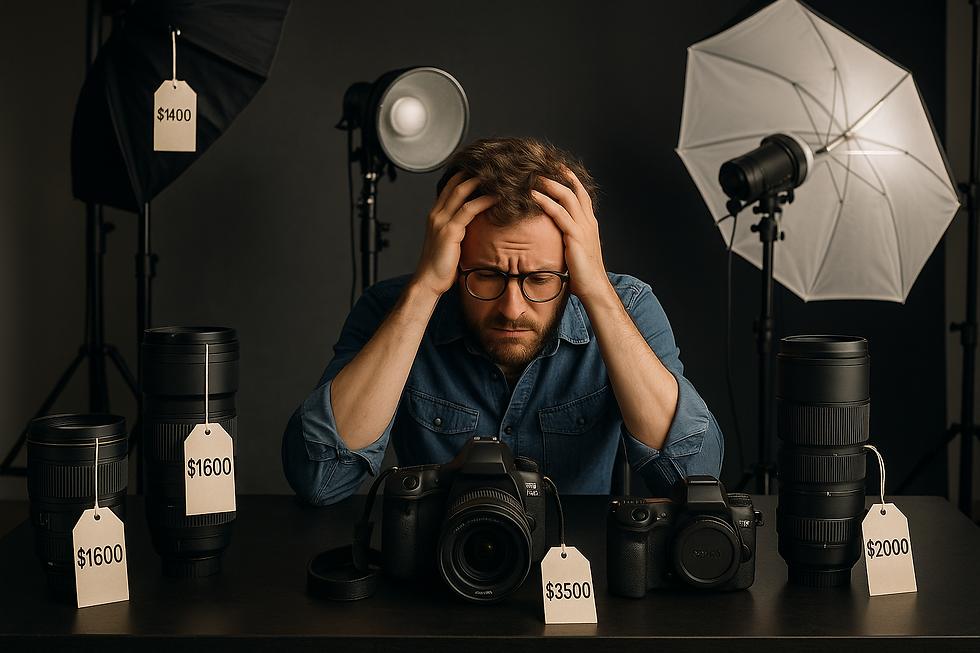Why 71.6% of People Can Spot Fake AI Photos (And How We Fixed That)
- Jaideep Singh

- Jun 25
- 8 min read
Picture this: You wake up on a random Tuesday, grab your phone, and within a couple of hours, you have a collection of stunning professional photographs of yourself in exotic locations around the world - without ever leaving your house, hiring a photographer, or buying a single outfit. This isn't science fiction. This is the reality of ultra-realistic AI photo shoots, and it's transforming how we think about photography forever.
But here's the thing that most people don't realize: not all AI photography is created equal. In fact, the differences between various AI image generation tools and AI photography studios are so vast that choosing the wrong one could leave you with images that look like they were made by a robot having a bad day.
The AI Photography Revolution is Here (And It's Bigger Than You Think)
Let's start with some mind-blowing numbers. The AI photography market was valued at $2.85 billion in 2024 and is projected to explode to $8.95 billion by 2033 - that's a compound annual growth rate of 13.6%. To put that in perspective, if AI photography growth were a person, it would be that friend who somehow gets promoted every six months while the rest of us are still figuring out how to use the office coffee machine.

But here's what's really fascinating: 85% of professional photographers predict significant industry changes within the next five years due to AI, yet 71.6% of consumers can still detect AI-generated images. This creates what I like to call the "Uncanny Valley Problem" - where AI gets close to reality but not quite close enough to fool our surprisingly sophisticated human brains.

The Current AI Image Generation Landscape: A Wild West of Possibilities
Right now, the AI image generation world looks like a bustling marketplace where everyone's selling slightly different flavors of the same basic product. Let's break down the major players and what they're actually good at:
The Big Names Everyone Talks About
ChatGPT: Think of this as the Swiss Army knife of AI image generation. It excels at prompt adherence and text integration, making it perfect when you need exactly what you ask for. If you tell it to create "a purple elephant wearing a business suit while riding a unicycle in Times Square," you'll get exactly that. The downside? Sometimes it's so focused on following instructions that it forgets to make things look naturally beautiful.
Midjourney: This is the artist of the group. Midjourney produces visually stunning, creative images that make you go "wow" even when you're not entirely sure what you're looking at. It's like that friend who can't draw a stick figure but somehow always takes the most Instagram-worthy photos. Perfect for abstract art and creative projects, but don't expect consistency if you're trying to maintain a specific look across multiple images.
Flux AI: The speed demon with serious computational muscle. Built by Black Forest Labs with 12 billion parameters, Flux can generate high-quality images up to 2 megapixels with impressive accuracy. What makes Flux interesting is its infrastructure flexibility - you can use it through platforms like fal.ai, replicate.ai, or host it yourself. From all the above, the realism produced by Flux models is pretty good and is currently SOTA.
HiDream AI: The newcomer that's making waves. This Chinese-developed model recently topped global rankings, beating mainstream models from Midjourney, OpenAI, and Google within 24 hours of its release. HiDream features innovations like Sparse DiT architecture that increases generation efficiency by 50% while cutting costs by 30%.
Tool | Strengths | Best Use Case | Infrastructure |
ChatGPT/DALL-E | Prompt adherence, text integration, consistency | Narrative-driven content, precise requirements | OpenAI hosted |
Midjourney | Artistic quality, creativity, visual appeal | Artistic projects, abstract visuals | Proprietary hosting |
Flux AI | Speed, efficiency, accuracy, 12B parameters | High-volume generation, realistic portraits | Multiple (fal.ai, replicate, self-hosted) |
HiDream AI | Cinematic quality, efficiency, cost reduction | Commercial design, anime production | Self-hosted by company |
Stable Diffusion | Customization, open-source, flexibility | Technical customization, developer use | Distributed hosting options |
Adobe Firefly | Professional integration, commercial licensing | Creative Cloud integration, professional workflows | Adobe Cloud infrastructure |
The Infrastructure Game: Why Hosting Matters More Than You Think
Here's where things get really interesting, and where most people's eyes start to glaze over - but stick with me, because this is actually crucial to understanding why some AI photography services are dramatically better than others.

Most AI startups in the photography space don't actually own their AI models. Instead, they're essentially fancy front-ends that make API calls to companies like fal.ai or replicate.com, which host and manage the actual AI infrastructure. It's like the difference between owning a restaurant and being a food delivery app - both serve food, but the level of control and quality assurance is completely different.
The API Dependency Problem
When companies rely on third-party API providers, several issues emerge:
Unpredictable Costs: API pricing can fluctuate based on demand
Quality Inconsistency: Updates to the underlying model can change output quality without warning
Limited Customization: You're stuck with whatever the API provider offers
Latency Issues: Multiple network hops can slow down generation times
Companies like fal.ai position themselves as "the fastest way to run diffusion models," promising up to 4x faster processing than alternatives. Replicate focuses on ease of deployment and reproducibility, allowing users to "run and fine-tune models" with simple APIs. Both are excellent platforms, but they're still intermediaries between you and the actual AI technology.
What Users Really Want: The Emotional Connection Factor
Here's something that might surprise you: when people choose an AI photography service, technical specifications aren't the primary deciding factor. Based on extensive research into consumer behaviour, users value three things above all else:
Predictability Over Creativity
While general AI image generators pride themselves on creative unpredictability, photography customers want the opposite. When someone uploads photos for an AI photoshoot, they want to look like themselves, just better, and in amazing settings. They don't want to play Russian roulette with their appearance.
A study of over 4,000 American consumers found that 71.6% can detect AI-generated images, and if they determine that AI images are poor quality or a bad fit, they may hold it against the brand. This means ultra-realistic AI photo shoots need to hit that sweet spot where the images are clearly enhanced but still authentically you.
Emotional Resonance
Users don't just want technically perfect images; they want photos that make them feel something. Whether it's confidence for a dating profile, professionalism for LinkedIn, or joy for social media, the emotional response is paramount. This is where the difference between generic AI image generation and specialized AI photography becomes crystal clear.

Convenience Without Compromise
The ideal AI photography service eliminates all the traditional barriers - travel, wardrobe, photographer scheduling, weather - without sacrificing quality. Users want the convenience of AI with results that rival or exceed traditional photography.
The Photo AI vs. Ultra Realistic AI Photoshoot Distinction
This is where things get technical, but I'll keep it simple. Most "Photo AI" tools are essentially sophisticated filters. They take your existing photo and apply various enhancements - smoother skin, better lighting, maybe a background change. Think of it as really advanced Instagram filters.

Ultra-realistic AI photoshoots, on the other hand, are generative experiences. Instead of modifying your existing photos, they create entirely new images of you in different settings, outfits, and scenarios while maintaining your core facial features and body characteristics. It's the difference between photo editing and photo creation.

How Self-Hosted Infrastructure Changes Everything
When an AI photography studio hosts their own models, several advantages emerge:
Complete Quality Control
Self-hosting means every aspect of the image generation pipeline can be optimized for the specific use case of realistic portraiture. Instead of using a general-purpose model designed for everything from landscapes to cartoon characters, the algorithms can be fine-tuned specifically for human photography.
Data Privacy and Security
Your photos never leave the company's secure servers. This is particularly important given that 83% of companies now consider AI a top business priority, making data security paramount.
Consistent Performance
No dependency on external API availability or pricing changes. Processing times remain predictable, and service quality doesn't fluctuate based on third-party infrastructure decisions.
Customization Capabilities
Self-hosted models can be continuously improved based on user feedback and specific use cases. This creates a feedback loop that constantly enhances the quality of ultra-realistic AI photo shoots.
The Market Reality: Numbers Don't Lie
The data reveals some fascinating trends about where AI photography is heading:
Statistic | Percentage |
Professional photographers predicting industry change in 5 years | 85 |
Photographers using AI tools for creativity | 60 |
Photographers using AI for workflow optimization | 45 |
Consumers can detect AI-generated images | 71.6 |
Professional photographers using AI for real-time analysis | 61 |
Companies saying AI is top business priority | 83 |
Photographers believing AI helps discover new techniques | 68 |

The statistics show that while 60% of photographers are using AI tools for creativity, and 68% believe AI helps them discover new techniques, there's still a significant gap between professional adoption and consumer satisfaction. This gap represents the opportunity for specialized AI photography studios to bridge the divide between cutting-edge technology and user expectations.
Why Luxe AI Studio Represents the Next Evolution
Here's where we get to the heart of what makes a truly differentiated AI photography experience. Based on our research, Luxe AI Studio embodies several key principles that address the fundamental limitations of current market solutions:
Proprietary Model Optimization
Instead of relying on general-purpose models through API services, Luxe AI Studio appears to focus specifically on ultra-realistic personalized photoshoots. This specialization allows for optimization that general tools simply can't achieve.
12-Hour Turnaround with Predictable Results
The service promises specific timelines and quality guarantees - something that's difficult to achieve when you're dependent on third-party APIs. This predictability addresses one of the users' primary concerns about AI photography services.
Comprehensive Package Approach
Rather than generating random images, the service offers structured packages for specific use cases: matrimony, dating, pre-wedding, social media, and professional portfolios. This shows an understanding that different contexts require different photographic approaches.
Data Security Priority
The commitment to deleting all related data after order completion addresses growing privacy concerns in the AI space. This level of data handling is much easier to guarantee when you control your own infrastructure.

The Future of Ultra-Realistic AI Photography
Looking ahead, several trends are converging to make AI photography even more sophisticated:
Real-Time Generation
With improvements in processing speed, we're moving toward instant AI photoshoot generation. Imagine uploading photos and seeing results in minutes rather than hours.
Hyper-Personalization
Future AI photography will understand not just how you look, but how you prefer to be portrayed. The AI will learn your style preferences and automatically adjust lighting, angles, and settings to match your personal aesthetic.
Seamless Integration
AI photography will become integrated into existing workflows and platforms. Instead of standalone services, expect AI photoshoot capabilities built into social media platforms, dating apps, and professional networking sites.
The Bottom Line: Choose Your AI Photography Partner Wisely
The AI photography landscape is evolving rapidly, but the fundamental choice remains the same: do you want a generic AI image generator that happens to work with photos, or do you want a specialized ultra-realistic AI photoshoot service designed specifically for creating authentic, emotionally resonant images of real people?
The market data suggests that specialized, self-hosted solutions will increasingly dominate the premium segment of AI photography. As consumers become more sophisticated about detecting AI-generated content, the demand for ultra-realistic results will only increase.
Whether you're looking to enhance your dating profile, create professional headshots, or capture memories in exotic locations without leaving home, the key is choosing a service that understands the difference between generating images and creating photographs that truly represent you.
The revolution in AI photography isn't just about better technology - it's about better understanding what people actually want from their photos: authenticity, emotional connection, and the confidence that comes from looking your absolute best. And that's a revolution worth being part of.




Comments